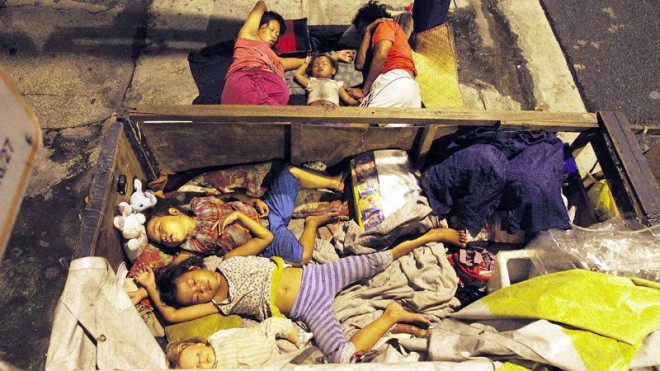12M families say they are poor in latest SWS report

HOME, STREET HOME A family makes its home on a street in Makati City, the site of the country’s top financial district. Millions of Filipinos go to bed hungry despite the soaring economy, according to the latest survey of the Social Weather Stations. EDWIN BACASMAS
MANILA, Philippines–A total of 12.1 million Filipino families considered themselves poor in September, while 9.3 million families said they were food-poor, according to a Social Weather Stations (SWS) report.
The nationwide survey, conducted from Sept. 26 to 29, found 55 percent of the respondents saying they were poor, the same as in the previous quarter.
The survey also found 43 percent saying they were food-poor in September, slightly more than the 41 percent recorded in June. Results of the survey were first published in BusinessWorld.
The latest self-rated poverty and self-rated food poverty levels were higher than those in the same period last year.
In September 2013, self-rated poverty was 50 percent while self-rated food poverty was 37 percent.
Article continues after this advertisementLast month’s self-rated poverty and food poverty rates (52 percent and 39 percent, respectively) were above the 2013 average.
Article continues after this advertisementThe survey used face-to-face interviews with 1,200 respondents and had a margin of error of plus-or-minus 3 percentage points.
On self-rated poverty, SWS asked 1,200 household heads to plot their family on a card with indicators stating “not poor,” “on the line” and “poor.”
For self-rated food poverty, respondents were told to plot their family on a card indicating whether they were “not poor,” “on the line” or “poor” on the basis of their food situation over the past three months.
Lot of work
Malacañang on Monday acknowledged that the government still has a lot of work to do to reduce poverty, following the SWS survey.
“The consistent and focused poverty alleviation measures that the government has undertaken shows a positive effect on the reduction of poverty,” presidential spokesman Edwin Lacierda told reporters.
“But, of course, we would always prefer to do better than what we have done now.”
In a separate statement, Communications Secretary Herminio Coloma Jr. noted that the poverty incidence dropped by three points from the first quarter of 2012 to the same period the following year, based on the Family Income and Expenditure Survey (FIES) of the Philippine Statistics Authority.
Coloma said the same survey also showed a 2.7-point decrease in the “proportion of extremely poor Filipino individuals who could not afford to meet basic food requirements” during the same period.
Lacierda pointed out that the level of poverty described in the latest SWS survey was “self-rated.”
“How come the people think that way? I don’t know. It’s a perception of the person so you really have to ask them,” he said.
“We respect those surveys. But, again, the effort [to reduce poverty is] continuous. Regardless of what the surveys say, we have a focused approach to addressing poverty issues.”
Up in Metro Manila, Luzon
Across areas, self-rated poverty increased in Metro Manila by six points, from 37 percent to 43 percent and in Luzon outside Metro Manila by seven points, from 45 percent to 52 percent.
Self-rated poverty fell in Mindanao by 10 points, from 71 percent to 61 percent and in Visayas by nine points, from 74 percent to 65 percent.
Self-rated food poverty went up from 27 percent to 30 percent in Metro Manila and from 32 percent to 37 percent in Luzon outside Metro Manila.
It barely moved in the Visayas, from 54 percent to 53 percent while it declined from 55 percent to 52 percent in Mindanao.
Under the Aquino administration, self-rated poverty ratings ranged between 45 percent and 55 percent, while self-rated food poverty ratings hovered between 35 percent and 45 percent.
The median self-rated poverty threshold, which is the monthly budget that would satisfy the poorer half of the poor households, rose in Metro Manila (from P12,000 to P15,000).
It stayed at P10,000 in the rest of Luzon and in Mindanao. In the Visayas, it dropped from P10,000 to P8,000.
“The September 2014 median self-rated poverty thresholds in Metro Manila, [the rest of] Luzon and Mindanao are at the highest levels ever reached in those areas, while the latest figure in the Visayas was previously surpassed in June 2014, when it was at P10,000,” SWS said.
The median self-rated food poverty threshold, the monthly food budgets that food-poor households need in order not to consider themselves food-poor, rose in Metro Manila (from P6,000 to P8,000), in Luzon outside Metro Manila (from P5,000 to 5,250) and in Mindanao (from P4,500 to P5,000). It declined in the Visayas (from P5,000 to P3,550).
SWS noted that the September median self-rated food-poverty thresholds in Mindanao and the rest of Luzon were the highest levels in those areas, while the September level in Metro Manila had been surpassed in the past.
In the Visayas, the highest level so far was the P5,000 recorded in June.
Latest data from the government’s Annual Poverty Indicators Survey (Apis) in 2013 showed that the poverty incidence among Filipino families was estimated at 19.1 percent in the first semester of 2013, lower than the 22.3 percent in the first semester of 2012.
The report, released by the Philippine Statistics Authority (PSA) in April, also showed that poverty incidence among Filipinos stood at 24.9 percent, lower than the 27.9 percent in the first semester of 2012.
The PSA now reports estimates of poverty incidence using income data from the Apis. Previous reports were based on the Family Income and Expenditure Survey conducted every three years.–Ana Roa, Inquirer Research and Christian V. Esguerra
RELATES STORIES
SWS: Self-rated poverty rises in NCR, Luzon; more say they are ‘food-poor’